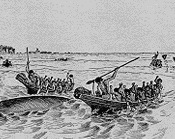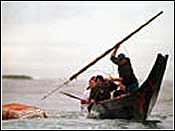
|
PREHISTORIC CULTURES OF NORTH AMERICA |
| S.Crouthamel, American Indian Studies/Anthropology, Palomar College |
|
SITE # 2 |
Ozette |
"Whale, I have given you what you wish to get - my good harpoon. Please hold it with your strong hands... Whale, tow me to the beach of my village, for when you come ashore there, young men will cover your great body with blue-bill duck feathers and the down of the great eagle." (Makah )

| I. History of Excavation |
Ozette is a prehistoric/historic Makah site on the Olympic Peninsula (Cape Alava) of Washington state. The historical whaling village was occupied from 400 B.C. to A.D. 1920, when the Makah Indian people were relocated north to Neah Bay for government schooling.
 Between 1966-1970 storms and tidal erosion began exposing older parts of the
village. Richard D. Daugherty (Washington State University) was notified by
tribal elders that the exposed artifacts were being pothunted and was able to
examine the site. From 1970-1982 Washington State University students and members of the Makah nation
embarked on the partial excavation of an the area of the village that was buried in a
mudslide about 500 years ago. This work resulted in the recovery of ~ 55,000
artifacts that ended up at the Makah
Cultural Center and Research Center.
Between 1966-1970 storms and tidal erosion began exposing older parts of the
village. Richard D. Daugherty (Washington State University) was notified by
tribal elders that the exposed artifacts were being pothunted and was able to
examine the site. From 1970-1982 Washington State University students and members of the Makah nation
embarked on the partial excavation of an the area of the village that was buried in a
mudslide about 500 years ago. This work resulted in the recovery of ~ 55,000
artifacts that ended up at the Makah
Cultural Center and Research Center.
| II. Cultural Context |
The Ozette Site represents about 2000 years of occupation along the Olympic Peninsula of the Late Period of the Northwest Coast. Northwest Coast people were primarily riverine fishing people that around 400 B.C. began moving from interior riverine sites to the bays along the Pacific Ocean which constituted a maritime adaptation. This also brought about an increase of sea mammal hunting, including whaling. The whaling and deep sea fishing necessitated the development of huge sea going canoes.

Whaling required skill and resources and was conducted by the nobility that
grew in power on the Northwest Coast.
At Ozette a mudslide in the Spring ~ A.D. 1750 destroyed an entire section of noble and commoner homes along the beach. This event created an anaerobic environment that preserved wood, bone, textile and cordage to create an unprecedented preservation of perishable artifacts (Ozette is sometime called the 'North American Pompeii).
|
|
Thus, artifacts that are not normally preserved are present in proportion to their normal quantitative sample. Further, Daugherty combined archaeological research with tribal knowledge such that cataloging utilized scientific preservation technology and ethnosemantic Makah language classification of artifacts as they were stored at the Makah research facility.
| III. Contemporary Status |
As funds ran out excavation ceased around 1982. Yet, artifacts were under the care of the Makah nation. Thus, the Makah Culture and Research Center was established and in 1992 a world class/ tribally run museum was established in Neah Bay. Many tribal artisans reproduced artifacts found at Ozette for display and a Makah language revival took place in conjunction with the culture center. Gill nets found at Ozette have been used in court cases demonstrating prehistoric use of nets. Recently, with considerable controversy, the Makah have conducted traditional whale hunts; sanctioned by the International Whaling Commission. The last traditional Makah hunt was in 1926 and the first modern hunt was in 1998.

The Ozette Archaeological Site is non accessible by vehicle but one can get permission to hike into the coastal area of Cape Flattery Trail from Neah Bay. The Ozette Archaeological Site is listed in the National Register of Historic Places.
Copyright © S. J. Crouthamel